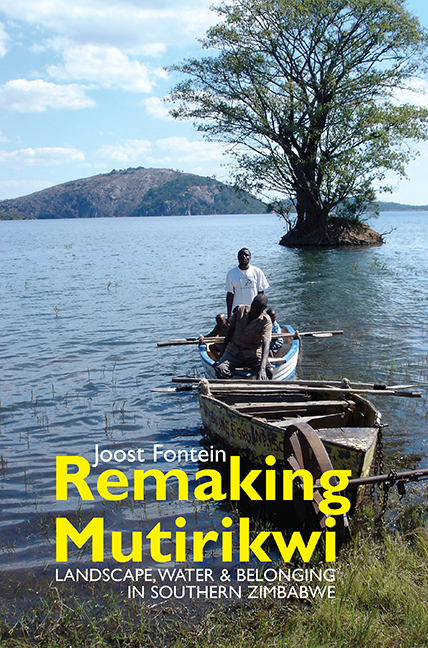Book contents
- Frontmatter
- Dedication
- Contents
- Illustrations
- Acknowledgements
- Note on Fieldwork, Notes & Sources
- Glossary
- Acronyms & Abbreviations
- Chronology
- Remaking Mutirikwi: An Introduction
- Part One Remaking Mutirikwi in the 2000s
- Part Two Damming Mutirikwi 1940s–1990s
- Epilogue: Remaking Mutirikwi in the late 2000s & early 2010s
- Bibliography
- Index
- Eastern African Studies
9 - Promising Returns & Frustrated Futures in the Wake of War, 1980s–1990s
Published online by Cambridge University Press: 11 June 2021
- Frontmatter
- Dedication
- Contents
- Illustrations
- Acknowledgements
- Note on Fieldwork, Notes & Sources
- Glossary
- Acronyms & Abbreviations
- Chronology
- Remaking Mutirikwi: An Introduction
- Part One Remaking Mutirikwi in the 2000s
- Part Two Damming Mutirikwi 1940s–1990s
- Epilogue: Remaking Mutirikwi in the late 2000s & early 2010s
- Bibliography
- Index
- Eastern African Studies
Summary
Although the residents of Victoria set about building their ‘playground’ with great gusto after the dam's completion, and the lowveld sugar industries expanded rapidly once water became available, African nationalism and war had brought danger and insecurity to Mutirikwi. White futures looked more precarious as African futures were increasingly full of promise. While the dangers accompanying war threatened everyone in different ways, for many cultural nationalism anticipated new African futures offering diverse promises of ‘return’. African pasts had not been obliterated by the dam and its remaking of Mutirikwi's landscapes. This chapter focuses on what happened around Mutirikwi after the war; a story told, in part, through the troubling biography of the Nehanda medium, Sophia Muchini. With independence in 1980, impatient aspirations of return to ancestral landscapes materialised in a wave of restless ‘squatting’ around Mutirikwi. But by the end of that decade many returnees had been evicted again, as older management plans for the Mutirikwi's recreational park were re-asserted. Some promised returns did take hold. Chikwanda's chieftaincy was restored; abandoned farms ‘reverted’ to communal land, or were resettled under smallholder schemes, as the Europeanisation of Mutirikwi's landscapes was partially undone. But many of the imagined African futures ascendant in the 1970s were disappointed. By the turn of the millennium for many independence had not delivered its promises. This set the scene for the return of radicalism and new land occupations in the 2000s, when, as Jairos Haruzvivishe put it, ‘the government said “ivhu kuvanhu”[soil to the people]’.
SOPHIA MUCHINI AND THE VICTORIA EAST FARM KILLINGS
Sophia Muchini, a self-proclaimed Nehanda medium, first arrived around Mutirikwi in 1974. Comrade Nylon and his men were suspicious of her loyalties, but there is evidence other comrades held her ‘in high regard during the war years’. Garlake noted she recruited people for guerrilla training, and was even ‘asked to become a guerrilla leader’ (1983:16). Rhodesian forces harassed her, her son was shot dead and she was imprisoned for six weeks in 1978 and again in 1979. After the war she re-established herself at Great Zimbabwe, where she was visited by ex-fighters from across the district and beyond, seeking ‘cleansing’ after the violence of war. She became involved in plans being discussed by some in the new ZANU PF government, notably Dr Ushewokunze, for a ceremony at Great Zimbabwe, when remains of war dead from Mozambique would be reburied.
- Type
- Chapter
- Information
- Remaking MutirikwiLandscape, Water & Belonging in Southern Zimbabwe, pp. 256 - 287Publisher: Boydell & BrewerPrint publication year: 2015

